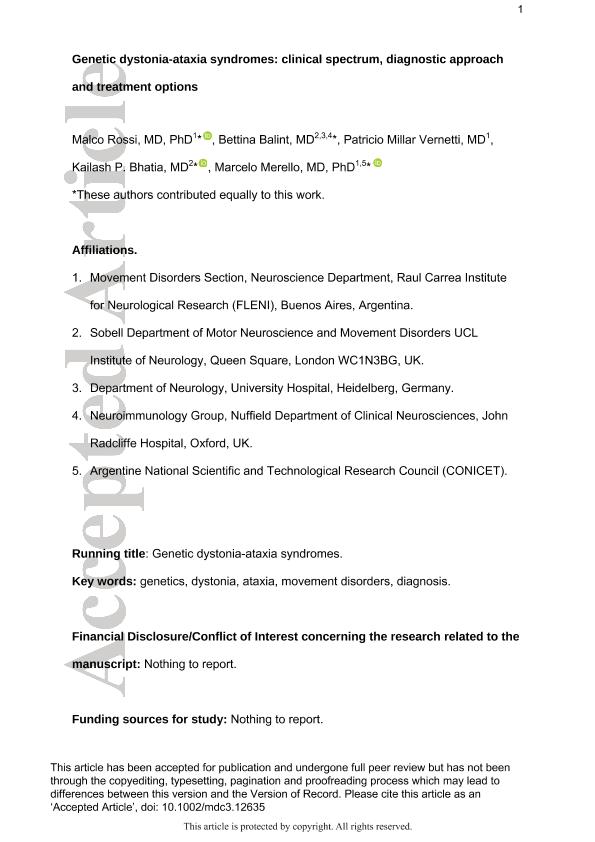Mostrar el registro sencillo del ítem
dc.contributor.author
Rossi, Malco
dc.contributor.author
Balint, Bettina
dc.contributor.author
Millar Vernetti, Patricio
dc.contributor.author
Bhatia, Kailash P.
dc.contributor.author
Merello, Marcelo Jorge

dc.date.available
2020-01-06T17:08:59Z
dc.date.issued
2018-05
dc.identifier.citation
Rossi, Malco; Balint, Bettina; Millar Vernetti, Patricio; Bhatia, Kailash P.; Merello, Marcelo Jorge; Genetic dystonia-ataxia syndromes: clinical spectrum, diagnostic approach and treatment options; Wiley Blackwell Publishing, Inc; Movement Disorders Clinical Practice; 5; 4; 5-2018; 373-382
dc.identifier.issn
2330-1619
dc.identifier.uri
http://hdl.handle.net/11336/93628
dc.description.abstract
Background: Dystonia and ataxia are manifestations of numerous disorders, and indeed, an ever-expanding spectrum of genes causing diseases that encompass dystonia and ataxia are discovered with the advances of genetic techniques. In recent years, a pathophysiological link between both clinical features and the role of the cerebellum in the genesis of dystonia, in some cases, has been proposed. In clinical practice, the genetic diagnosis of dystonia-ataxia syndromes is a major issue for genetic counseling, prognosis and, occasionally, specific treatment. Methods: For this pragmatic and educational review, we conducted a comprehensive and structured literature search in Pubmed, OMIM, and GeneReviews using the key words “dystonia” and “ataxia” to identify those genetic diseases that may combine dystonia with ataxia. Results: There are a plethora of genetic diseases causing dystonia and ataxia. We propose a series of clinico-radiological algorithms to guide their differential diagnosis depending on the age of onset, additional neurological or systemic features, and imaging findings. We suggest a sequential diagnostic approach to dystonia-ataxia syndromes. We briefly highlight the pathophysiological links between dystonia and ataxia and conclude with a review of specific treatment implications. Conclusions: The clinical approach presented in this review is intended to improve the diagnostic success of clinicians when faced with patients with dystonia-ataxia syndromes.
dc.format
application/pdf
dc.language.iso
eng
dc.publisher
Wiley Blackwell Publishing, Inc

dc.rights
info:eu-repo/semantics/openAccess
dc.rights.uri
https://creativecommons.org/licenses/by-nc-sa/2.5/ar/
dc.subject
ATAXIA
dc.subject
DIAGNOSIS
dc.subject
DYSTONIA
dc.subject
GENETICS
dc.subject
MOVEMENT DISORDERS
dc.subject.classification
Otras Ciencias de la Salud

dc.subject.classification
Ciencias de la Salud

dc.subject.classification
CIENCIAS MÉDICAS Y DE LA SALUD

dc.title
Genetic dystonia-ataxia syndromes: clinical spectrum, diagnostic approach and treatment options
dc.type
info:eu-repo/semantics/article
dc.type
info:ar-repo/semantics/artículo
dc.type
info:eu-repo/semantics/publishedVersion
dc.date.updated
2019-12-20T22:57:16Z
dc.journal.volume
5
dc.journal.number
4
dc.journal.pagination
373-382
dc.journal.pais
Estados Unidos

dc.description.fil
Fil: Rossi, Malco. Fundación para la Lucha contra las Enfermedades Neurológicas de la Infancia; Argentina
dc.description.fil
Fil: Balint, Bettina. Institute of Neurology; Reino Unido. John Radcliffe Hospital; Reino Unido. University Hospital; Alemania
dc.description.fil
Fil: Millar Vernetti, Patricio. Fundación para la Lucha contra las Enfermedades Neurológicas de la Infancia; Argentina
dc.description.fil
Fil: Bhatia, Kailash P.. Institute of Neurology; Reino Unido
dc.description.fil
Fil: Merello, Marcelo Jorge. Fundación para la Lucha contra las Enfermedades Neurológicas de la Infancia; Argentina. Consejo Nacional de Investigaciones Científicas y Técnicas; Argentina
dc.journal.title
Movement Disorders Clinical Practice
dc.relation.alternativeid
info:eu-repo/semantics/altIdentifier/url/http://doi.wiley.com/10.1002/mdc3.12635
dc.relation.alternativeid
info:eu-repo/semantics/altIdentifier/doi/http://dx.doi.org/10.1002/mdc3.12635
Archivos asociados
